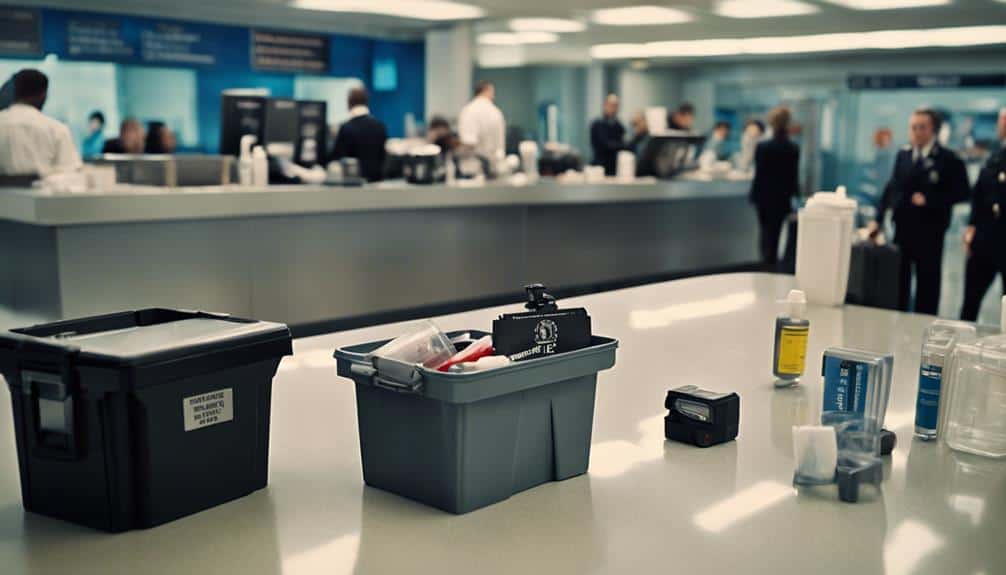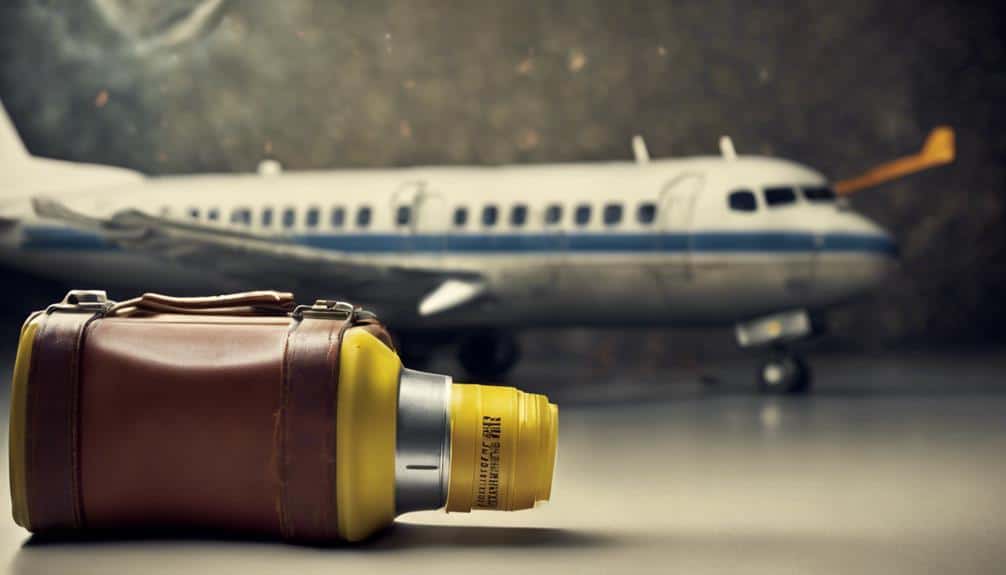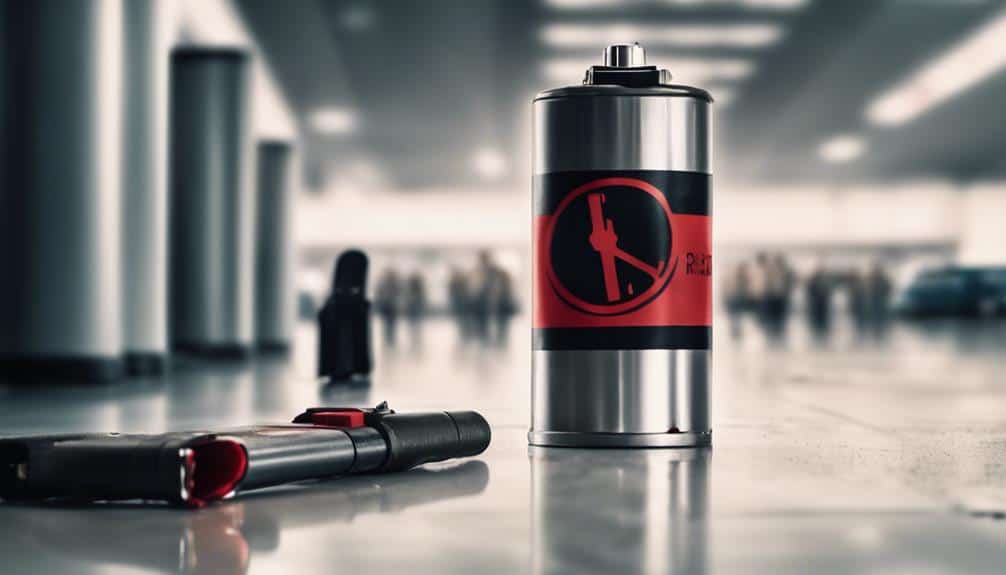Sky-High Safety: Can You Really Bring Pepper Spray on a Plane?
You might think bringing pepper spray on a plane is a smart safety move, but TSA’s got strict rules! You can’t stash it in your carry-on, but you can pack a 4-ounce container in your checked luggage—just make sure it has a safety mechanism and less than 2% tear gas. Be mindful that some airlines and international laws might be even stricter. You don’t want your trip to start with a confiscation or a fine, right? Always double-check before you fly, because, let’s face it, nobody wants their vacation ruined before it even begins! Want the full scoop? Keep going!
 When bringing pepper spray on a plane, you need to know the TSA regulations and specific airline policies to avoid fines or confiscation.
First off, TSA regulations are pretty clear: pepper spray isn’t allowed in your carry-on luggage. You’ve got to stash it in your checked baggage. The container can’t be bigger than 4 ounces and must have a safety mechanism to prevent accidental spray attacks while in transit.
Now, don’t think you can just toss any old pepper spray in there. It must contain less than 2% tear gas (CS or CN). If you’re planning an international flight, you’ll need to do a bit of homework. Different countries have their own rules, and some places are super strict about pepper spray.
Also, don’t forget about airline regulations. Airlines can sometimes be pickier than the TSA, so double-check with your airline before you pack. Missing this step could mean losing your pepper spray or facing penalties when you arrive at the airport.
When bringing pepper spray on a plane, you need to know the TSA regulations and specific airline policies to avoid fines or confiscation.
First off, TSA regulations are pretty clear: pepper spray isn’t allowed in your carry-on luggage. You’ve got to stash it in your checked baggage. The container can’t be bigger than 4 ounces and must have a safety mechanism to prevent accidental spray attacks while in transit.
Now, don’t think you can just toss any old pepper spray in there. It must contain less than 2% tear gas (CS or CN). If you’re planning an international flight, you’ll need to do a bit of homework. Different countries have their own rules, and some places are super strict about pepper spray.
Also, don’t forget about airline regulations. Airlines can sometimes be pickier than the TSA, so double-check with your airline before you pack. Missing this step could mean losing your pepper spray or facing penalties when you arrive at the airport.
 When you bring pepper spray on a plane, you’re not just breaking rules, you’re risking everyone’s safety.
Imagine the chaos if it accidentally goes off mid-flight—people coughing, eyes burning, and flight attendants scrambling.
Plus, with cabin pressure changes, that little canister could turn into a ticking time bomb, ready to explode in your luggage.
When you bring pepper spray on a plane, you’re not just breaking rules, you’re risking everyone’s safety.
Imagine the chaos if it accidentally goes off mid-flight—people coughing, eyes burning, and flight attendants scrambling.
Plus, with cabin pressure changes, that little canister could turn into a ticking time bomb, ready to explode in your luggage.
 Understanding the legal considerations for carrying pepper spray is essential to guarantee you’re not caught off guard by local or international regulations.
First off, it’s important to know that pepper spray is generally prohibited in carry-on luggage. The TSA is pretty strict here. However, if you’re set on bringing it, you’re allowed one 4-ounce container in your checked baggage. Just make sure it contains less than 2% mass of tear gas and has a safety mechanism to prevent accidental discharge.
Now, let’s talk local laws. They can be as unpredictable as airport Wi-Fi! Some states require permits, while others have restrictions on who can carry pepper spray. Before you toss it in your bag, check the local laws to avoid any surprises.
Traveling internationally? Buckle up, because many countries have even stricter regulations against carrying pepper spray. A quick Google search could save you from hefty fines or legal issues. Trust me, you don’t want your trip ruined by a TSA officer confiscating your spray, or worse, getting tangled in a legal mess abroad.
Understanding the legal considerations for carrying pepper spray is essential to guarantee you’re not caught off guard by local or international regulations.
First off, it’s important to know that pepper spray is generally prohibited in carry-on luggage. The TSA is pretty strict here. However, if you’re set on bringing it, you’re allowed one 4-ounce container in your checked baggage. Just make sure it contains less than 2% mass of tear gas and has a safety mechanism to prevent accidental discharge.
Now, let’s talk local laws. They can be as unpredictable as airport Wi-Fi! Some states require permits, while others have restrictions on who can carry pepper spray. Before you toss it in your bag, check the local laws to avoid any surprises.
Traveling internationally? Buckle up, because many countries have even stricter regulations against carrying pepper spray. A quick Google search could save you from hefty fines or legal issues. Trust me, you don’t want your trip ruined by a TSA officer confiscating your spray, or worse, getting tangled in a legal mess abroad.
Regulations and Guidelines

Airline-Specific Policies
Knowing TSA’s regulations is just the first step; you also need to understand the specific policies of the airline you’re flying with. Airlines have their own rules about pepper spray, and they can be pretty strict! For instance, Delta, Hawaiian, JetBlue, Southwest, and United all allow you to pack one 4-ounce container of pepper spray in your checked baggage. But don’t even think about putting it in your carry-on baggage—it’s strictly prohibited. Now, here’s where things get tricky. Some airlines, like United and JetBlue, can be even stricter. They mightn’t allow pepper spray in your checked luggage at all. Imagine getting to the airport only to find out your safety spray is a big no-go. Yikes! That’s why it’s essential to double-check the airline-specific policies before you pack. And remember, your pepper spray must have a safety mechanism to prevent accidental discharge. You don’t want it going off in your luggage—talk about an explosive situation! If you don’t follow these rules, your pepper spray could be confiscated, or worse, you could face penalties. So stay informed, and you’ll fly with peace of mind!In-Flight Risks

Cabin Pressure Changes
Cabin pressure changes can cause aerosol containers like pepper spray to explode, posing serious health and safety risks. Think about it: you’re up in the sky, and the cabin pressure starts changing. The gases inside aerosol spray containers, like pepper spray, expand. This can lead to leaks or even ruptures. Now imagine that happening in a confined airplane cabin—yikes! If you’re considering packing pepper spray, the TSA has specific rules. You can only bring it in checked bags, and it must have a safety mechanism to prevent accidental discharge. Why? Because the risks are real. The pressure changes can turn that little canister into a ticking time bomb. Here’s a quick breakdown:| Item | Risk |
|---|---|
| Pepper Spray | Explosion due to pressure |
| TSA Regulations | Only in checked bags |
| Safety Mechanism | Prevents accidental discharge |
| Aerosol Containers | Prone to leaks or ruptures |
| Cabin Pressure | Causes gas expansion |
Accidental Discharge Hazards
Imagine the chaos and health risks if a canister of pepper spray accidentally discharges mid-flight. Picture the confined space of an airplane, cabin pressure changes, and suddenly, a cloud of pepper spray fills the air. Passengers could be coughing, eyes burning, and panic spreading. It’s not just uncomfortable; it’s a safety nightmare. You might think keeping pepper spray in your checked luggage is a safe bet, but think again. With cabin pressure fluctuations, aerosol cans, including pepper spray, can explode, causing serious damage to luggage and posing a risk to the aircraft’s integrity. That’s why TSA regulations are strict about these items. They’re banned from carry-on luggage to prevent such accidental discharges and the mayhem that could follow. Airport security measures these risks carefully, but you should too. Airlines often have additional restrictions to guarantee your journey is smooth and safe. For your personal safety and that of others, it’s essential to comply with these rules. No one wants their vacation kickoff to be an unscheduled landing because of a pepper spray mishap.Health Complications Risks
Exposing passengers to pepper spray in-flight can lead to severe health complications, including respiratory issues and eye irritation. Imagine you’re cruising at 30,000 feet, and suddenly, someone’s pepper spray accidentally discharges. Not only does it cause chaos, but it also poses serious health risks. The confined space of an airplane makes it more dangerous, as the aerosol spreads quickly, affecting everyone nearby. You wouldn’t want to be gasping for air or rubbing your burning eyes while stuck in a metal tube hurtling through the sky, right? Respiratory distress from pepper spray can be particularly nasty, especially since the cabin’s recycled air can make symptoms worse. Eye irritation is no joke either—tears, redness, and pain can leave you miserable for the rest of the flight. The TSA security rules exist for a reason. Aerosol sprays like pepper spray can become safety hazards due to cabin pressure changes, potentially causing them to explode. It’s not just about your safety but everyone’s. Plus, flight diversions or emergency landings due to such in-flight risks aren’t exactly the adventure you signed up for.Safe Travel Practices
When traveling with pepper spray, it’s crucial to follow safe travel practices to confirm compliance and avoid any issues. The Transportation Security Administration (TSA) has strict rules about what’s allowed in carry-on luggage. Unfortunately, pepper spray isn’t one of them. But don’t worry, you can pack one 4-ounce container in your checked baggage, as long as it contains less than 2% tear gas and has a safety mechanism to prevent accidental discharge. Before you hit the skies, make certain to double-check your airline’s travel regulations. Some airlines are stricter and mightn’t allow pepper spray at all. It’s always better to be safe than sorry and avoid any surprises at the airport. To keep things secure, confirm your pepper spray is properly packaged. A locking mechanism is a must, and clear labeling can help smooth out the process. And hey, consider carrying a personal alarm instead. It’s a handy alternative for feeling safe without the hassle. Stay updated on TSA regulations and your airline’s policies. A little research goes a long way in making your travel experience stress-free. Safe travels and happy adventures!Legal Considerations

Pepper Spray Alternatives
Several effective alternatives to pepper spray can guarantee your safety while adhering to travel regulations. You don’t need to worry about sneaking self-defense sprays through security when there are plenty of other options that are both legal and practical. Personal alarms are a fantastic choice. These compact devices emit high-decibel sounds that can attract attention and scare off potential threats. Plus, you can bring them on planes without any hassle. Safety whistles are another great option. They’re lightweight, battery-free, and perfect for signaling for help in emergencies. If you prefer something more hands-on, self-defense keychains can be very effective. They’re designed for personal safety and don’t have the regulatory issues that pepper spray does. And don’t forget about flashlights with strobe modes. They’re not just for lighting your way; the strobe can disorient attackers in low-light situations. Researching local laws is essential because some alternatives may face fewer restrictions, especially when traveling internationally. Here’s a quick comparison to help you decide:| Alternative | Key Feature |
|---|---|
| Personal Alarms | High-decibel sound to attract attention |
| Safety Whistles | Lightweight, battery-free signaling |
| Self-Defense Keychains | Effective with fewer regulatory issues |
| Flashlight with Strobe | Useful light source, disorient attackers |
Frequently Asked Questions
Can You Bring Pepper Spray on a Plane and Carry-On?
You can’t bring pepper spray in your carry-on due to TSA’s pepper spray regulations. Check airline policies as well. It’s essential for personal safety and travel security, but non-compliance can lead to confiscation and legal implications.What Self-Defense Weapons Can Go Through Tsa?
When considering personal safety while traveling, know that TSA allows personal alarms and self-defense keychains, but other non-lethal weapons face strict travel restrictions. Always check self-defense laws and airport security rules to avoid legal consequences.Is Pepper Spray Allowed in Cabin?
No, you can’t bring pepper spray in your cabin baggage. According to pepper spray regulations and airline safety policies, it’s on the prohibited items list. For travel safety tips, check self-defense laws and passenger rights before flying.Can I Bring Spray on a Plane?
You can’t bring spray in your carry-on due to airline regulations and travel safety concerns. For personal protection, check self-defense options allowed in checked baggage. Always review prohibited items and travel tips to pass security screenings smoothly.
Facebook
Twitter
LinkedIn
Pinterest


One Response